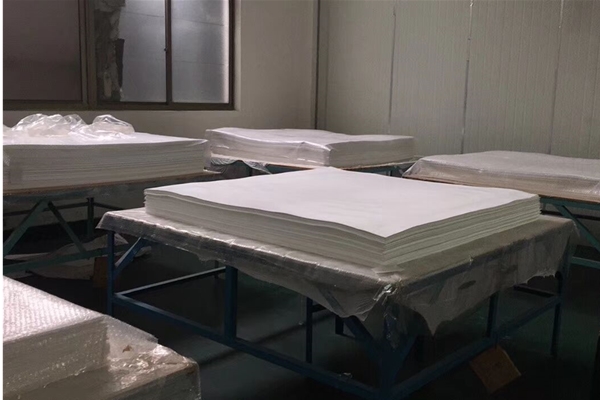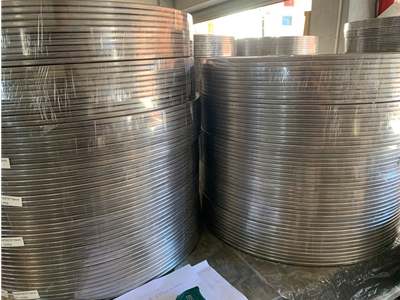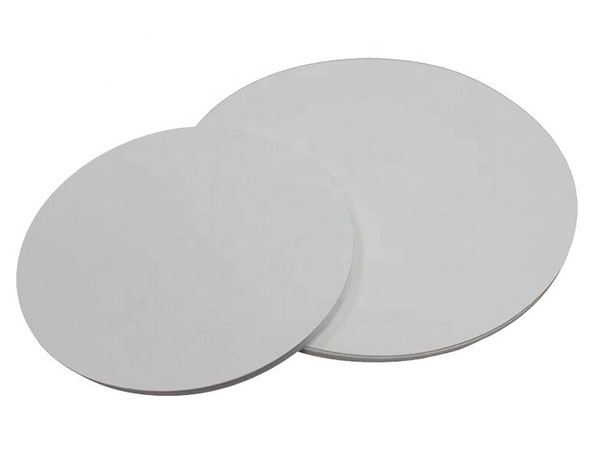Expanded polytetrafluoroethylene (ePTFE) film is produced from PTFE and engineered to deliver a unique micro-porous “fibril–node” network. The method below is an improvement over conventional ePTFE film production. It balances two critical properties that typically trade off in filtration films—air permeability and tensile break force—while improving uniformity and surface appearance for continuous, high-volume manufacturing.
Why PTFE, and Why ePTFE for Filtration
PTFE offers excellent high- and low-temperature performance, outstanding chemical stability, and good dielectric properties and hydrophobicity. ePTFE film prepared from PTFE as the raw material is a high-performance membrane for filtration and particle separation, widely applied in the filtration of dust-laden flue gases in cement, metallurgy, and power industries to satisfy environmental protection and clean-production requirements.
ePTFE film has a microscopic “fibril–node” network structure. Air permeability is one of its key physical parameters, determining the ease with which dust-laden gas passes through the medium and indicating the medium’s gas-transfer performance. Tensile break force (F) is another important parameter. Referring to the international standard for tensile break force testing, film strength P and tensile break force F are measured, with the relationship F = P × S, where S is the cross-sectional area of the specimen. At constant specimen width, S is proportional to thickness; thus, at constant P, F is proportional to film thickness. The higher the tensile break force of the film, the longer its service life. However, as a filtration medium, if the ePTFE film is too thick, air permeability declines and filtration performance worsens. How to produce ePTFE film that exhibits both high air permeability and high tensile break force is a technical challenge in current domestic and international ePTFE film production.
In ePTFE film preparation, the reduction ratio is a critical parameter closely related to product quality. Generally, increasing R·R helps raise film strength, so current extrusion steps typically employ higher R·R to enhance strength. Meanwhile, the conventional process uses a circular die head. Due to the extrudate bar’s height, resistance is high when entering the calender, and the circular die gives poor lateral spreading. Therefore, in the conventional route, calendering follows extrusion.
Under this “extrude-then-calender” mode, when the extruded strip passes through calender rolls, material flows both toward the center and the edges. The center flow velocity is often greater than at the sides, causing non-uniform flow across the strip, which readily leads to tearing or skirt edges. At the microscopic level, PTFE material is prone to pre-fibrillation, creating numerous striations that compromise the uniformity of the “fibril–node” network and degrade the film’s appearance.
Our Improved ePTFE Film Method
To address these issues, a new ePTFE film preparation method is proposed. It can simultaneously account for air permeability and tensile break force and significantly improve the internal “fibril–node” network uniformity and surface appearance. The sequence is mixing, preforming, extrusion, MD stretching, TD stretching, characterized by the use of a flat (slit) die in extrusion and the addition of a nipping step between extrusion and MD stretching.
Specific process steps and conditions:
Mixing: Thoroughly stir the selected PTFE resin with processing aids.
Preforming: Place the uniformly mixed material in an oven at 40 °C to fully wet, then preform into a cylindrical billet using a preforming device.
Extrusion: Use a flat-slit die head for flat-die extrusion. Control extrusion load pressure at 3–4 MPa and extrusion speed at 1–5 m/min, converting the cylindrical billet into a flat strip sheet.
Supercalendering (nipping): Pass the extruded flat strip through pressure rolls with an in-line pressure of 20–30 kg/cm and a draw speed of 1–5 m/min to form a wide tape of 150–500 µm thickness.
MD stretching: Stretch the wide tape at 100–250 °C to obtain a machine-direction-oriented base tape.
TD stretching: Stretch the MD base tape transversely at 50–350 °C, then cure/set at 340–370 °C to obtain the ePTFE film.
In extrusion, the flat-slit die has a width-to-gap aspect ratio of 70–250:1, and the reduction ratio is in the range of 10–50.
How Do We Optimize and What Does It Mean for Industrial Filtration
The die is the shaping tool for producing the extruded strip and plays an important role in product air permeability, thickness, uniformity, and appearance. Abandoning the conventional circular die and selecting a high-aspect-ratio flat-slit die provides a new means of obtaining a wide, flat base tape directly from extrusion.
From the reduction-ratio formula, R·R is closely related to die-orifice design. With the preform cavity area S₁ fixed, the die-orifice area S₂ determines R·R. Increasing S₂ reduces R·R, lowers billet densification, and improves final film air permeability. Practice shows that using the specified die aspect ratio and R·R ranges can, on the basis of meeting permeability, increase film thickness appropriately to improve tensile break force and extend service life.
If, after extrusion through a flat-slit die with low R·R, the traditional calendering step were still used, it would magnify extrusion-strip appearance defects. Compared with circular dies and high R·R, the billet density is lower; calendering (elongating, widening, and thinning) generates large internal material displacements, inevitably causing non-uniform appearance, especially at lower billet densities.
In this production route, nipping follows extrusion. Nipping applies uniform transverse pressure to the extruded strip, mitigating non-uniformities caused by large shape transitions. After nipping, the particle-level uniformity improves—i.e., the uniformity of the “fibril–node” network—and the surface smoothness of the extruded strip is enhanced.
Experiments show that, under the same R·R and film thickness, the greater the flat-die aspect ratio, the better the film appearance quality.
Using this process with the same flat-die aspect ratio, and producing ePTFE films of comparable thickness at different R·R, when R·R is reduced from 50 to 10 (−80%), air permeability increases by 143%, while MD strength decreases by 23.4% and TD strength decreases by 19.5%. The percentage increase in permeability far exceeds the percentage decrease in strength.
Likewise, using the same flat-die aspect ratio and the same R·R, when producing ePTFE films of different thickness, increasing thickness from 15.8 µm to 40.1 µm (+154%) reduces air permeability by only 26.3%, with strength essentially unchanged, while MD tensile break force increases by 169% and TD tensile break force increases by 197%. The percentage decrease in permeability is much lower than the percentage increase in tensile break force.
Summary of Advantages
In summary, by selecting an appropriate flat die aspect ratio, reducing the reduction ratio, and appropriately increasing film thickness, this method can simultaneously increase air permeability and tensile break force. The resulting ePTFE films exhibit high permeability, high tensile break force, high uniformity, and good appearance (see Table 3 for representative properties). The invention is suitable for continuous mass production of ePTFE films with stable appearance and performance, and effectively improves ePTFE product performance for filtration applications.




